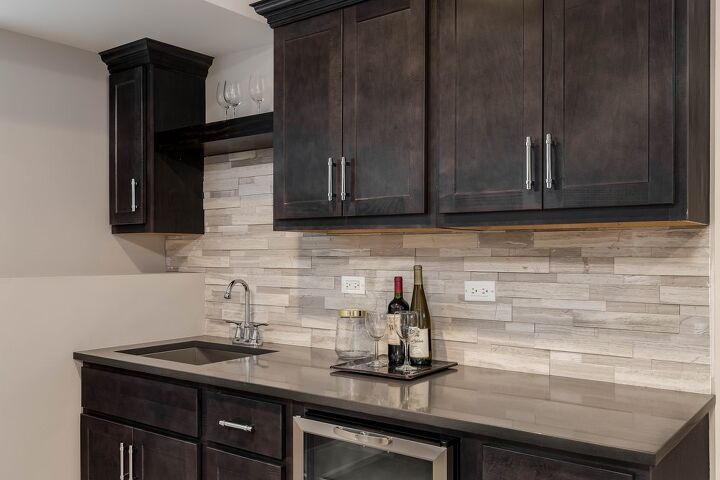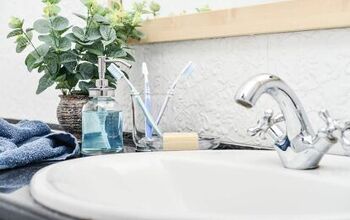Standard Bar Sink Dimensions (with Pictures)

A bar sink can make entertaining in your home much easier. Also known as a utility or prep sink, a bar sink is useful when the kitchen sink is in high demand. Use this as a guide to determine the type of bar sink and size you need in your home.
Bar sinks are smaller than standard sinks and come in several different shapes and sizes. On average, bar sinks are 15 to 25 inches long, 15 inches wide, and 5 to 10 inches deep. Round bar sinks typically have a diameter ranging from 9 to 18 inches.
What’s the Average Size of a Bar Sink?
You can use bar sinks as an extra sink in home bars and entertaining areas. They can be a place to quickly rinse and wash a glass or fill with ice to keep drinks cool. They are usually small in size, round or square, and made of stainless steel or copper.
A bar sink is usually recognized because they are smaller in size than an average kitchen sink. Standard kitchen sinks are 22 to 33 inches wide, whereas bar sinks are usually 9 ½ to 18 inches wide. These sinks are perfect for families who have multiple cooks or for those who often host parties.
Rectangular bar sinks have a length of 9 to 18 inches on each side and a depth of 6 to 10 inches. Circular bar sinks are usually 9 to 18 inches in diameter with a depth of 7 to 10 inches.
What Type of Faucet Do You Need for a Bar Sink?
Because bar sinks are smaller, they often require a different type of faucet than a standard kitchen sink. Bar sink faucets have a more narrow profile than kitchen faucets. They are available in the same styles and finishes as standard faucets and blend well with other kitchen fixtures.
The faucet needs to be higher to allow access to the bowl of the sink. Bar sink faucets usually have a spout height of 8 to 13 inches. If the tap is too high for the depth of the sink, water will splash out when the faucet is on.
The faucet should also extend over the sink in the right area. If it’s too far over the drain or behind the drain, there will be splashing or interference when in use.
When purchasing a faucet, make sure it’s compatible with the bar sink. Some bar sinks have holes for faucets with a distance of 4 inches or 8 inches between the handles. Other bar sinks don’t have faucet drillings, so the faucet is mounted directly onto the countertop.
Bar Sink Styles
Bar sinks come in different shapes and styles, but the first choice you need to make is the bowl configuration. The most common bowl configuration for a bar sink is single bowl sinks with a narrow single basin sink. The most common shapes for bar sinks are oval, round, and square, but custom shapes are available.
Bar Sink Installation Options
Typically, bar sinks are installed near an open countertop space. This makes prepping food easy as you can sweep any debris into the sink if there is a garbage disposal.
There are a variety of methods for installing a bar sink. They each produce a different look for the countertop. Each installation option requires a different type of sink, so it’s important to know what you need before buying.
Drop-in Bar Sink
A drop-in bar sink, also known as a self-rimming sink, is designed to be installed from the top down. The sink drops into the cutout hole in the countertop. These sinks have a ledge that rests flat on the countertop.
Drop-in bar sinks are relatively easy to install as a do-it-yourself project. These sinks can cost $60 to $500 depending on the material used and size.
Undermount Bar Sink
An undermount bar sink is attached to the underside of the countertop. Ledges fit under the countertop, just inside the cutout hole. The sink then sits on the shelves, and you glue the sink edges into place.
Undermount sinks are usually on the heavier side, so it’s a good idea to have a professional install the sink. These sinks can run $170 to $2,000
Apron Front Sink
Apron front sinks, or farmhouse sinks, are not common for bar sinks. However, some designs are under 18 inches, so they do qualify as a bar sink.
These sinks also require professional installation since only three sides connect to the countertop. Therefore, you must support the weight from below. Apron front sinks can cost $360 to $2,000.
Things to Consider When Choosing a Bar Sink
There are four critical factors to remember when deciding what size bar sink you need.
Here’s what you should consider:
- The size of the counter and cabinet that will hold the bar sink.
- How much available space exists between the top of the pipes and the bottom of the sink.
- Any storage space in the cabinet under the sink.
- The available counter space.
- What you plan to use the bar sink for.
The Area That Will Hold the Bar Sink
Wet bar sinks mount on base cabinets. When choosing the sink, it should be at least 3 inches smaller than the base cabinet you’re anchoring it on.
Measure the length and width of your base cabinet, then subtract 3 inches. For example, if the base cabinet is 20 by 15 inches, the bar sink should be 17 by 12 inches.
Plumbing Space Under the Bar Sink
As with any type of sink, the size of the sink you get will depend on the space under your sink. You will need to determine the depth of the area your sink will sit in. There should be enough space between your pipes and the bottom of the sink.
Measure the height of the pipes under the sink and the depth of the sink to ensure there is enough space. If you have flexible pipes, this isn’t as big of a concern.
Storage Space in the Cabinet
You should also consider any shelving units or drawers under the cabinet that could get in the way of the installation. Be aware of the depth of the sink. You don’t want to rid yourself of storage space in the kitchen because the sink is the wrong depth.
Altering your base cabinet may also void the warranty and could potentially not hold the weight of the sink. Additionally, if you have to remove or redesign shelving in the base cabinet, this could increase your renovation budget.
Available Counter Space for Your Bar Sink
Don’t forget about counter space when installing a bar sink. The intended use for the sink and the area around it will help determine the size sink you need. If you need a food prep area or space for other kitchen items, you don’t want the sink to take up counter space.
If you are short on counter space, consider getting a smaller sink or a fitted cutting board. A fitted cutting board sits over the sink, adding more counter space to work when the faucet isn’t in use.
How Will You Use Your Bar Sink
Before deciding on the size bar sink you need, consider what you will be using it for. If you only need it to access water for drinks, you may not need a big sink. Conversely, if you want to use it for storing several beers on ice, you probably need a bigger sink.
That said, most people do prefer a more oversized sink. To get an idea of how much room you need, use your main sink as a prep sink as a test. This can help you see how much space you use and what size bar sink you will need.
If you plan to wash tall wine glasses or other dishes in your bar sink, make sure to measure them. Then, place the wine glasses in the main sink and measure the area required. This will give you an idea of the size bar sink you’ll need.
Related Questions
What is the difference between a wet bar sink and a dry bar sink?
The main difference between a wet bar and a dry bar sink is the faucet and access to running water. A wet bar sink includes a faucet, whereas a dry bar sink does not. If you already have the plumbing for a wet bar sink, it’s usually a better option. Wet bar sinks are generally more recommended because they’re more practical, especially if you enjoy entertaining. A wet bar sink offers all the functionality of a dry bar sink, so keep that in mind when choosing.
What’s the average price to install a bar sink?
On average, bar sink installation, including labor, is $399, but most homeowners pay $215 to $592. Depending on where you live, costs can range from $100 to $1,100 or more. The cost of your project will also depend on the type of sink being installed and the amount of labor needed. If you have a more complex bar sink installation, like an apron front sink, expect to pay more. Drop-in sinks, however, may not cost as much as they are easy installation.

Stacy Randall is a wife, mother, and freelance writer from NOLA that has always had a love for DIY projects, home organization, and making spaces beautiful. Together with her husband, she has been spending the last several years lovingly renovating her grandparent's former home, making it their own and learning a lot about life along the way.
More by Stacy Randall































